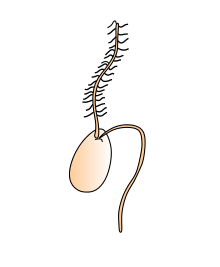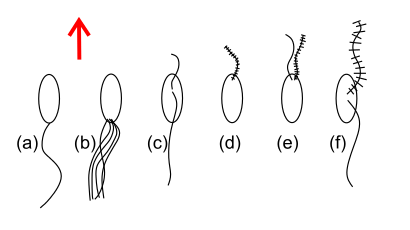Zoospore
A zoospore is a motile asexual spore that uses a flagellum for locomotion. Also called a swarm spore, these spores are created by some protists, bacteria and fungi to propagate themselves.

Heterokont zoospore of Saprolegnia with tinsel and whiplash flagella.
Diversity
Flagella types
Zoospores may possess one or more distinct types of flagella: tinsel or "decorated", and whiplash, in various combinations.
- Tinsellated (also known as straminipilous[1]) flagella have lateral filaments known as mastigonemes perpendicular to the main axis which allow for more surface area, and disturbance of the medium, giving it the property of a rudder, that is, the purpose of being used for steering.
- Whiplash flagella are straight, to power the zoospore through its medium. There is also the 'default' zoospore, which only has the propelling, 'whiplash' flagella.
Both tinsel and whiplash flagella beat in a sinusoidal wave pattern, but when both are present, the tinsel will beat in the opposite direction of the whiplash, to give 2 axes of control of motility.
Morphological types

Figure 1. Zoospore types. The arrow indicates direction of movement.
In eukaryotes there are four main types of zoospore,[1] illustrated in Fig. 1 at right:
- Opisthokont. Posterior whiplash flagella, a characteristic of Chytridiomycota, and a proposed uniting trait of the Opisthokonts, a large clade of eukaryotes containing animals and fungi. In most of these, there is a single posterior flagellum (Fig. 1a), but in Neocallimastigales, there are up to 16 (Fig. 1b)
- Anisokont. Biflagellates zoospores with two whip types flagella of unequal length (Fig. 1c). These are found in some Myxomycota and Plasmodiophoromycota.
- Zoospores with a single anterior flagellum (Fig. 1d) of the tinsel type, characteristic of Hyphochytriomycetes.
- Heterokont. Biflagellate zoospores (Fig. 1e, f) with both whiplash(smooth) and tinsel type(fine outgrowths called mastigonemes) flagella attached anteriorly or laterally. These Zoospores are characteristic of Oomycota and other Heterokonts.
Zoosporangium
A zoosporangium is the asexual structure (sporangium) in which the zoospores develop in plants, fungi, or protists (such as the Oomycota)
gollark: It's great!
gollark: Presumably there are *other*, *less unethical* jobs available.
gollark: TJ09 working at Facebook makes me like him even *less*!
gollark: Because of stupid rules saying that the Wants "must be applicable to multiple users".
gollark: Strictly speaking, they're not allowed to actually *say* "for original owner".
See also
References
- Webster, John; Weber, Roland (2007). Introduction to Fungi (3rd ed.). Cambridge: Cambridge University Press. pp. 23–24. ISBN 9780521014830.
- Alexopolous, C. J.; Mims, Charles W.; Blackwell, M.; et al. (2004). Introductory Mycology (4th ed.). Hoboken, New Jersey: John Wiley and Sons. ISBN 0-471-52229-5.
External links

This article is issued from Wikipedia. The text is licensed under Creative Commons - Attribution - Sharealike. Additional terms may apply for the media files.